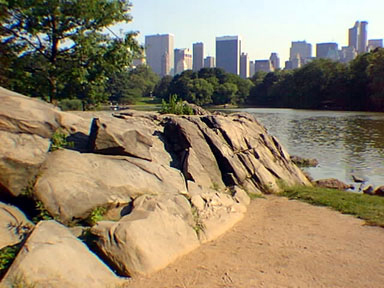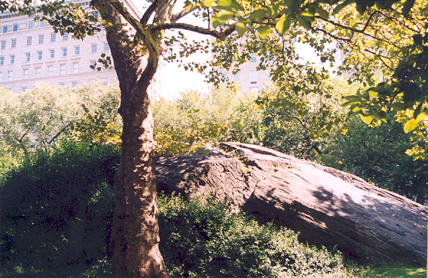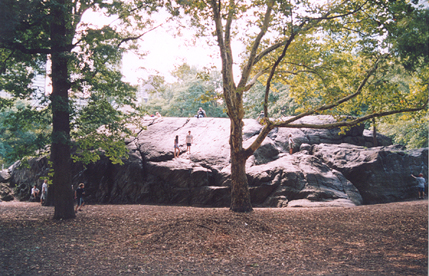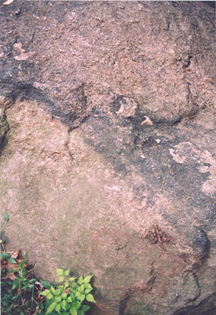Geotimes

Untitled Document

Travels in Geology
September 2004
The center of it all: visiting
Central Park
 As most
native New Yorkers and visitors to New York City know, the city offers seminal
architecture, world class shopping and well-known sites, such as Ellis Island,
the Brooklyn Bridge and the Statue of Liberty. Among these celebrated sites
is the crown jewel of Manhattan's park system, Central Park. Integral to park
planners Frederick Law Olmstead and Calvert Vaux's design are deftly incorporated
outcrops of the metamorphic rock schist lining the edges and dotting the landscape
of the 843-acre park.
As most
native New Yorkers and visitors to New York City know, the city offers seminal
architecture, world class shopping and well-known sites, such as Ellis Island,
the Brooklyn Bridge and the Statue of Liberty. Among these celebrated sites
is the crown jewel of Manhattan's park system, Central Park. Integral to park
planners Frederick Law Olmstead and Calvert Vaux's design are deftly incorporated
outcrops of the metamorphic rock schist lining the edges and dotting the landscape
of the 843-acre park.
Glaciers left their mark all over New
York's Central Park. To the right is a glacially scoured outcrop of gneiss and
schist on the west side of the park, with the Midtown skyline behind. Photo
courtesy of the U.S. Geological Survey.
Every day, thousands of people walk their dogs, jog and play sports in Central
Park, casually passing the half-billion-year-old rocks that at one point were
nearly 30 kilometers deep within the Earth. "The park presents a treasure
trove of important geologic information," says geologist Charles Merguerian
of Hofstra University and Duke Geological Laboratory, a geotechnical firm based
in New York City. "We are fortunate to have such a phenomenal teaching
laboratory preserved for us to enjoy."
 In
Merguerian's field guide to Central Park, he recommends
starting at the entrance off 64th Street on the east side of the park, where
the zoo is the first feature you encounter. If you turn right and walk north,
passing beneath the arch with the dancing bear, the outcrops begin to appear:
low ground-hugging hillocks shadowed beneath sycamores and oaks and great multistory
slabs of stone bathed in bright light, ideal for climbing and exploration.
In
Merguerian's field guide to Central Park, he recommends
starting at the entrance off 64th Street on the east side of the park, where
the zoo is the first feature you encounter. If you turn right and walk north,
passing beneath the arch with the dancing bear, the outcrops begin to appear:
low ground-hugging hillocks shadowed beneath sycamores and oaks and great multistory
slabs of stone bathed in bright light, ideal for climbing and exploration.
Starting at the Central Park entrance
nearest the zoo — 64th Street
— the first outcrop you encounter
is the Hartland formation, pictured here. The Hartland is one of two different
schists you will see when visiting the park. Its dark gray color and easily
visible layering distinguish it from outcrops of the second schist formation
in the park, the Manhattan. Photo by Sarah Todd Davidson.
The rocks in the south of the park come from sediment that originally was deep
in the ocean. When a volcanic arc collided with the east coast of North America,
it pushed sediment along in front of the arc, driving it deep into Earth. The
heat and pressure of Earth's interior altered the physical features of the once
sedimentary rocks to create the rocks we can now investigate. Eventually these
metamorphosed rocks were returned to the surface through uplift and erosion,
resulting in our ability to observe them before a Broadway show, or following
a visit to the Metropolitan Museum of Art.
The outcrops retain the dark gray color of their origins, but metamorphosis
created an abundance of micas, the shiny, planar minerals that reflect like
glass in the sun, as well as parallel lines within the rocks, called foliation,
which impart a layered look to the outcrops. White streaks of quartz cut through
the formations and are a result of molten rock forced within the cracks of the
schist, creating an igneous rock called a pegmatite when the melt solidified.
You can also see swirling patterns within the outcrops, a consequence of partial
melting at depth, and folding features that display the effects of pressure
bending the rock.
 Wandering
the meandering paths of the park, you can see features in one rock that distinguish
it from the one before, but certain outcrops are more interesting than others.
Across the baseball field from the children's carousel is on especially intriguing
piece of stone. Appropriately named Umpire's Rock, it is "the most spectacular
outcrop in the south of the park," Merguerian writes in the field guide.
Here you can observe many of the impressions of the rock's more recent past.
Wandering
the meandering paths of the park, you can see features in one rock that distinguish
it from the one before, but certain outcrops are more interesting than others.
Across the baseball field from the children's carousel is on especially intriguing
piece of stone. Appropriately named Umpire's Rock, it is "the most spectacular
outcrop in the south of the park," Merguerian writes in the field guide.
Here you can observe many of the impressions of the rock's more recent past.
To the left is Umpire's Rock, where visitors
can observe signs of the park's glacial past: a glacial trough, erratics and
glacial grooves. To the right you can see rocks of the Manhattan formation,
the once undivided name given to all the visible schist in New York City. Its
pink color and lack of layering distinguish it from the Hartland. Photos by
Sarah Todd Davidson.
Not to be outdone by the effects of the Earth's interior are glacial events
that made their own mark on the rocks once they reached the surface. On Umpire's
Rock you can observe a glacial trough, where the ice gouged away a smooth-edged
path through the outcrop, as well as glacial erratics — rocks that are
not original to the outcrop, but carried and deposited in that location by the
moving ice. Also visible are glacial grooves, thin lines cut out of the rock
by the passage of rocks and sediment within the ice sheet, in two directions,
which helps demonstrate the existence of separate glacial events.
Possessing features that would interest a geochemist or a five-year-old, a structural
geologist or a grandmother, this open-air laboratory is hands-on and interactive.
The proximity of Central Park to the everyday routines of New Yorkers, as well
as the areas of typical interest to visitors of the city, allow fieldtrips to
the city's geological spots for 10 minutes or the entire day. The park offers
a unique opportunity to investigate the foundation of the island of Manhattan,
the very center of New York City, breaching the surface for our aesthetic and
scientific benefits.
Sarah Todd Davidson
Geotimes contributing writer
Links:
Central
Park Conservancy
City
of New York Parks and Recreation
USGS
Central Park Geology
Merguerian's
Central Park Geology Field Guide
Read more Travels in
Geology.
Back to top
Untitled Document

 As most
native New Yorkers and visitors to New York City know, the city offers seminal
architecture, world class shopping and well-known sites, such as Ellis Island,
the Brooklyn Bridge and the Statue of Liberty. Among these celebrated sites
is the crown jewel of Manhattan's park system, Central Park. Integral to park
planners Frederick Law Olmstead and Calvert Vaux's design are deftly incorporated
outcrops of the metamorphic rock schist lining the edges and dotting the landscape
of the 843-acre park.
As most
native New Yorkers and visitors to New York City know, the city offers seminal
architecture, world class shopping and well-known sites, such as Ellis Island,
the Brooklyn Bridge and the Statue of Liberty. Among these celebrated sites
is the crown jewel of Manhattan's park system, Central Park. Integral to park
planners Frederick Law Olmstead and Calvert Vaux's design are deftly incorporated
outcrops of the metamorphic rock schist lining the edges and dotting the landscape
of the 843-acre park. In
Merguerian's field guide to Central Park, he recommends
starting at the entrance off 64th Street on the east side of the park, where
the zoo is the first feature you encounter. If you turn right and walk north,
passing beneath the arch with the dancing bear, the outcrops begin to appear:
low ground-hugging hillocks shadowed beneath sycamores and oaks and great multistory
slabs of stone bathed in bright light, ideal for climbing and exploration.
In
Merguerian's field guide to Central Park, he recommends
starting at the entrance off 64th Street on the east side of the park, where
the zoo is the first feature you encounter. If you turn right and walk north,
passing beneath the arch with the dancing bear, the outcrops begin to appear:
low ground-hugging hillocks shadowed beneath sycamores and oaks and great multistory
slabs of stone bathed in bright light, ideal for climbing and exploration. 
 Wandering
the meandering paths of the park, you can see features in one rock that distinguish
it from the one before, but certain outcrops are more interesting than others.
Across the baseball field from the children's carousel is on especially intriguing
piece of stone. Appropriately named Umpire's Rock, it is "the most spectacular
outcrop in the south of the park," Merguerian writes in the field guide.
Here you can observe many of the impressions of the rock's more recent past.
Wandering
the meandering paths of the park, you can see features in one rock that distinguish
it from the one before, but certain outcrops are more interesting than others.
Across the baseball field from the children's carousel is on especially intriguing
piece of stone. Appropriately named Umpire's Rock, it is "the most spectacular
outcrop in the south of the park," Merguerian writes in the field guide.
Here you can observe many of the impressions of the rock's more recent past.
